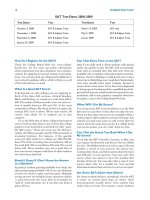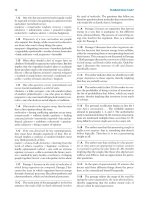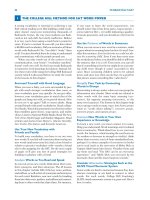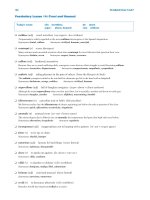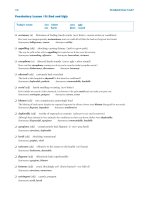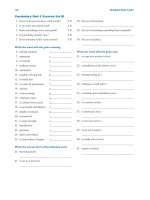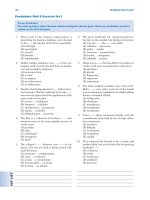Sat - MC Grawhill part 80 pptx
Bạn đang xem bản rút gọn của tài liệu. Xem và tải ngay bản đầy đủ của tài liệu tại đây (195.9 KB, 10 trang )
780 MCGRAW-HILL’S SAT
3 3 333 3
GO ON TO THE NEXT PAGE
1. Jacques Lugard’s world-renowned 34th-Street
bistro is known best for its main courses,
but many go there simply to enjoy the restau-
rant’s desserts.
(A) delectable . . scrumptious
(B) unpalatable . . tantalizing
(C) divine . . bland
(D) debilitating . . uninspired
(E) savory . . mediocre
2. Decades of political have left the region
on the brink of war; the slightest could
cause it to explode into destructive conflict.
(A) dissension . . construct
(B) tension . . communication
(C) harmony . . instigation
(D) strife . . provocation
(E) unanimity . . agitation
3. For over 500 years, the smile on the Mona Lisa
has been the source of much among art
historians, who continue to interpret her enig-
matic expression in many different ways.
(A) assent
(B) deliberation
(C) concurrence
(D) remuneration
(E) reconciliation
4. Even after his death, Elvis Presley continues to
be one of the most singers of all time;
every year hundreds of thousands of fans
travel to his hometown to pay tribute to his
memory.
(A) satirized
(B) unexalted
(C) revered
(D) despised
(E) shunned
SECTION 3
Time—25 minutes
24 questions
Turn to Section 3 of your answer sheet to answer the questions in this section.
Directions: For each question in this section, select the best answer from among the choices given and
fill in the corresponding circle on the answer sheet.
Each sentence below has one or two blanks,
each blank indicating that something has been
omitted. Beneath the sentence are five words
or sets of words labeled A through E. Choose
the word or set of words that, when inserted
in the sentence, best
fits the meaning of the
sentence as a whole.
EXAMPLE:
Rather than accepting the theory unquestion-
ingly, Deborah regarded it with
.
(A) mirth
(B) sadness
(C) responsibility
(D) ignorance
(E) skepticism
A
C D
E
B
5. Professional poker player Howard Lederer is
known as “the professor” because of the
tactics he uses to outthink his opponents.
(A) entertaining
(B) obscure
(C) cerebral
(D) transparent
(E) outlandish
6. Detractors of the new building say that it is
aesthetically and furthermore that, far
from being the financial that its develop-
ers claimed it would be, the project has cost
the city dearly in lost revenue.
(A) an eyesore . . adversary
(B) an enhancement . . gratuity
(C) an embellishment . . windfall
(D) a defacement . . calamity
(E) an atrocity . . boon
7. Nineteenth-century author Edgar Allen Poe
was acclaimed for his inventiveness; he
had an unmatched ability to write tales
of cruelty and torture that mesmerized his
readers.
(A) tenuous . . spellbinding
(B) grotesque . . enthralling
(C) interminable . . sacrilegious
(D) eclectic . . sadistic
(E) chimerical . . mundane
8. DNA evidence taken from the scene of the
crime was used to the defendant; the
genomic “fingerprint” taken from the blood
sample was not a match for the accused, thus
proving his innocence.
(A) perambulate
(B) expedite
(C) incriminate
(D) exculpate
(E) equivocate
CHAPTER 16 / PRACTICE TEST 4 781
3 3 333 3
GO ON TO THE NEXT PAGE
Questions 9 and 10 are based on the following passage.
Debussy, though less radical harmonically
than Schoenberg, preceded him in starting
the breakdown of the old system. Debussy,
one of the most instinctive musicians who
ever lived, was the first composer of our time
who dared to make his ear the sole judge of
what was good harmonically. With Debussy,
analysts found chords that could no longer be
explained according to the old harmony. If
one had asked Debussy why he used such
chords, I am sure he would have given the
only possible answer: “I like it that way!” It
was as if one composer finally had confidence
in his ear. I exaggerate a little, for, after all,
composers have never had to wait for theo-
reticians to tell them what or what not to do.
On the contrary, it has always been the other
way about—theoreticians have explained the
logic of the composer’s thought after he has
instinctively put it down.
9. It can be inferred from the passage that the
“old system” (line 3) most likely involved
(A) a way of developing musical intuition
(B) a rigid method for writing musical
harmonies
(C) a means by which musicians could in-
corporate the ideas of theoreticians into
their music
(D) a method of transcribing music that
arose spontaneously from a musician’s
imagination
(E) methods that theoreticians used for dis-
tinguishing the harmonies of different
composers
First passage:
What to Listen for in Music
, Aaron Copland,
McGraw-Hill, 1957. Reprinted with permission of the Aaron
Copland Fund for Music, Inc., Copyright owner.
Second passage:
The Oceans
, Ellen J. Prager; McGraw-Hill,
2000. Reprinted with permission of The McGraw-Hill
Companies.
The passages below are followed by questions
based on their content. Answer the questions
on the basis of what is stated
or implied in the
passage and in any introductory material that
may be provided.
Line
5
10
15
20
10. The passage characterizes Debussy primarily
as being
(A) less self-assured than other composers of
his time
(B) reverential of traditional musical forms
(C) preoccupied more with musical theory
than with practice
(D) harmonically inventive
(E) derisive of musical theoreticians
Questions 11 and 12 are based on the following passage.
Imagine flying in a hot-air balloon over the
lush, green canopy of a rainforest. Through
the clouds and mist you can barely make out
the treetops and a few of the birds flying
among them. What lies hidden in the under-
growth? How many organisms are there, what
do they look like, and how do they behave?
Using a rope and bucket you blindly drag the
rainforest from above hoping to ensnare some
of its inhabitants or the materials that make
up its infrastructure. But alas, with such fee-
ble and limited means you can learn little
about the environment and life below. For
years this is essentially how we have studied
the ocean—blindly sampling the sea with lim-
ited and relatively ineffective methods. Even
today, with technology as advanced as it is,
study of the ocean remains a difficult and ex-
pensive task. Whether through large-scale
satellite imagery, small-scale chemical and bi-
ological measures, or even the collecting of
fossil impressions of ancient sea creatures, all
aspects of oceanographic study require some
type of observation or sample collection, and
herein lies the problem.
11. The passage describes a trip in a hot-air bal-
loon primarily in order to
(A) describe the variety of life forms in the
rainforest
(B) make an analogy to ocean exploration
(C) exemplify the advanced equipment that
land-based biologists have at their disposal
(D) show the difficulties that most biologists
encounter in extracting samples from the
rainforest
(E) demonstrate how methods of biological
exploration have evolved over time
782 MCGRAW-HILL’S SAT
Questions 13–17 are based on the following passage.
The following is an excerpt from a book about
the history of primitive art.
Pictures from the earliest artistic periods
are the traces of a primal concept of the
world. In spite of the thematic treatment of
real creatures we can still recognize, paintings
of animals or men from the early Stone Age
are charged with magical strength, exagger-
ated and concentrated as they are into forms
of existential experience. They fulfilled still
other functions beyond the mere representa-
tion of the visible.
The degree of naïveté in archaic primitive
art varies. A certain naïveté is always present
when observation of nature is not overlaid
with rational thought. Art first had to discover
the world and to invent ways of making it per-
ceivable. Along with visible things, invisible
forces too were given form and substance and
began to make their appearance. And as they
achieved form they took on permanence.
The early hunters attempted to influence
the chance fortunes of the hunt through magi-
cal practices. The power of magic was as real
to them as the power of the stone ax they had
invented. Art ensnared the form of the animal.
3 3 333 3
GO ON TO THE NEXT PAGE
12. The “small-scale chemical and biological mea-
sures” (lines 20–21) are mentioned primarily
as examples of
(A) methods that are not as cost-effective or
simple as the author would like
(B) challenges for the explorer of the
rainforest
(C) technologies that hold great promise for
revealing the nature of oceanic life
(D) techniques that require little or no train-
ing to employ
(E) inexpensive means of exploring the deep-
est parts of the ocean
Line
5
10
15
20
Line
5
10
15
20
25
CHAPTER 16 / PRACTICE TEST 4 783
3 3 333 3
GO ON TO THE NEXT PAGE
Whenever the figure of woman appears it is a
sign of fertility; representations of men are
rarer, and when they occur they show him in
his role as hunter. Man does not yet look be-
yond the borders of existence that mark his
practical life. Magic precedes the fall of man
into knowledge.
It must have meant a considerable revolu-
tion in prehistoric times when man discov-
ered that he did not have to live solely from
hunting, that not only the animals but indeed
all of nature round about him was full of life.
Stars and seasons take their rhythms from un-
known forces; a mysterious power functioning
beyond human understanding, propitious or
forbidding, helpful or threatening; forces of
ancestors, spirits, and demons, and forces of
the departed and the coming gods.
With the transition from the early to the
late Stone Age there appears the first stylistic
change in art. The original naturalism based
on observation and experience gives way to a
geometrically stylized world of forms discov-
erable only through thought and speculation.
Prehistoric man, leaving behind him the
life of the hunter and gatherer, invents abbre-
viations and pictographic signs which are no
longer pictures proper but rather thought
models, reflections of his more settled exis-
tence as a beginning herdsman and farmer.
Following the late Stone Age, the art of the
Bronze Age—which in Asia dates from the mid-
dle of the third millennium
B.C. and which
began in Europe around 2100
B.C.—contains,
as does the art of the Iron Age as well, elements
of naïveté and inventive immediacy side by side
with highly developed, formalized composi-
tions. The bronze sculptures of the Celts and
the Illyrians are ample witnesses to them.
With the substitution of conceptual ratio-
nalization for more primitive, mythical expla-
nations of the world, a kind of art arises in
which objective criteria of reality and the nat-
ural laws of optics come into play. The sim-
plicity and vividness of the naïve become
more rare.
The art of the period of the catacombs was
informed with the naturalistic naïveté of late
antiquity. In medieval Christian art, which
was averse to any spatial illusions, a “moral”
perspective dominated; all action was pressed
onto the holy, two-dimensional surface.
While the primitive and instinctual accom-
panies the course of art until the Renaissance, it
recedes in the face of the humanistic concept of
the world and the discovery of linear and aerial
perspective. High art forsakes the realm of in-
stinct in exchange for the province of reason.
But parallel with it, in folk art and among
so-called primitive peoples, naïve representa-
tion lives on.
13. The first paragraph suggests that the “primal
concept of the world” (lines 2–3) involved
(A) a belief that art was more important
even than hunting
(B) a need to preserve a record of events for
the future
(C) a focus on the realistic depiction of
animals
(D) a sense that paintings can have powers
beyond what can be seen
(E) a desire to communicate with animals
14. In line 6, the word “charged” most nearly means
(A) exchanged
(B) approached violently
(C) accused
(D) trampled
(E) filled
15. The “stylistic change” (lines 44–45) is a transi-
tion from
(A) representations of real things to repre-
sentations of ideas
(B) magical applications of art to representa-
tions of hunting scenes
(C) depictions of gods to depictions of
herdsmen
(D) art used to depict the natural environ-
ment to art used for magical rituals
(E) a focus on the theme of hunting to a
focus on the theme of fertility
25
30
35
40
45
50
55
60
65
70
Masters of Naïve Art,
Oto Bihalji-Merin. Reprinted with
permission of The McGraw-Hill Companies.
75
80
85
16. The “bronze sculptures of the Celts and the
Illyrians” (lines 62–63) are mentioned primarily
as examples of
(A) a new appreciation of three-dimensional art
(B) art with both primitive and formal
characteristics
(C) a revival of the art of the Stone Age
(D) illustrations of the herding life
(E) art with moralistic themes
17. The passage indicates that, unlike the “art of
the period of the catacombs” (line 71), Renais-
sance art is characterized by
(A) an appreciation of three-dimensional forms
(B) an emphasis on religious themes
(C) representations of magical creatures
(D) a primitive view of the world
(E) a focus on the realm of instinct
Questions 18–24 are based on the following passage.
The following passage, from a modern textbook on
anthropology, discusses a debate among biologists
and anthropologists about how humans evolved.
Does evolution occur gradually or in “punc-
tuated equilibria”? Charles Darwin, a gradual-
ist, maintained that life forms arise from
others in a gradual and orderly fashion. Small
modifications that accumulate over the gener-
ations add up to major changes after millions
of years. Gradualists cite intermediate fossils
as evidence for their position, contending that
there would be even more transitional forms
if it weren’t for gaps in the fossil record.
The advocates of the punctuated equilib-
rium model believe that long periods of equi-
librium, during which species change little,
are interrupted (punctuated) by sudden
changes—evolutionary leaps. One reason for
such jumps in the fossil record may be extinc-
tion followed by invasion by a closely related
species. For example, a sea species may die out
when a shallow body of water dries up, while a
closely related species will survive in deeper
waters. Then, later, when the sea reinvades the
first locale, the protected species will extend its
range to the first area. Another possibility is
that when barriers are removed, a group may
replace, rather than succeed, a related one be-
cause it has a trait that makes it adaptively su-
perior in the environment they now share.
784 MCGRAW-HILL’S SAT
When a major environmental change occurs
suddenly, one possibility is for the pace of evo-
lution to increase. Another possibility is extinc-
tion. The earth has witnessed several mass
extinctions—worldwide ecosystem ca-
tastrophes that affect multiple species. The
biggest one divided the era of “ancient life” (the
Paleozoic) from the era of “middle life” (the
Mesozoic). This mass extinction occurred 245
million years ago, when 4.5 million of the
earth’s estimated 5 million species (mostly in-
vertebrates) were wiped out. The second
biggest extinction, which occurred 65 million
years ago, destroyed the dinosaurs and many
other Mesozoic species. One explanation for
the extinction of the dinosaurs is that a mas-
sive, long-lasting cloud of gas and dust arose
from the impact of a huge meteorite. The cloud
blocked solar radiation and therefore photo-
synthesis, ultimately destroying most plants
and the chain of animals that fed on them.
The hominid fossil record exemplifies both
gradual and rapid change, confirming that
evolution can be faster or slower depending
on the rate of environmental change, the
speed with which geographic barriers rise or
fall, and the value of the group’s adaptive re-
sponse. Australopithecine teeth and skulls
show some gradual transitions. For example,
some of the fossils that are intermediate be-
tween Australopithecus and early Homo com-
bine a larger brain (characteristic of Homo)
with huge back teeth and supportive structures
(characteristic of the australopithecines). How-
ever, there is no doubt that the pace of hominid
evolution sped up around 18 million years ago.
This spurt resulted in the emergence (in just
200,000 years) of Homo erectus. This was fol-
lowed by a long period of relative stability. The
probable key to the rapid emergence of Homo
erectus was a dramatic change in adaptive
strategy: greater reliance on hunting through
improved tools and other cultural means of
adaptation. The new economy, tools, and phe-
notype arose and spread rapidly, then re-
mained fairly stable for about 1 million years.
Anthropology: The Exploration of Human Diversity,
Conrad Phillip
Kottak, McGraw-Hill. Reprinted with permission of The
McGraw-Hill Companies.
Line
5
10
15
20
25
30
35
40
45
50
55
60
65
70
3 3 333 3
GO ON TO THE NEXT PAGE
22. According to the passage, the early Mesozoic
era differed from the late Paleozoic era chiefly
in that the early Mesozoic era
(A) was no longer dominated by the dinosaurs
(B) was characterized by the rise of Homo
erectus
(C) was characterized by a greater diversity
of life than that in the late Paleozoic era
(D) was far colder than the late Paleozoic era
(E) contained far fewer species than the late
Paleozoic era did
23. According to the passage, “the pace of hominid
evolution sped up around 18 million years
ago” (lines 62–63) most likely because
(A) Australopithecus developed a larger brain
(B) Homo erectus developed better means of
hunting and social interaction
(C) Homo erectus invaded and took over the
environment of Australopithecus
(D) Australopithecus developed large teeth,
which enabled it to eat a wider variety of
foods
(E) a natural catastrophe, perhaps a meteor,
destroyed many species that were com-
peting with the hominids
24. Given the information in the passage as a
whole, how would the author most likely an-
swer the opening question of the passage?
(A) The gaps in the fossil record indicate
clearly that all organisms evolve in punc-
tuated equilibrium.
(B) The example of Homo erectus demon-
strates that no species can remain stable
for very long.
(C) The rapidity with which species evolve de-
pends on many factors, so evolution can
occur gradually or in a punctuated manner.
(D) Only occasional mass extinctions inter-
rupt the gradual evolution of species.
(E) The father of evolution, Charles Darwin,
was correct in believing that all species
evolve gradually over long periods of time.
18. The passage suggests that the existence of “tran-
sitional forms” (line 9) would demonstrate
(A) how some species have come to domi-
nate others
(B) how life first arose on earth
(C) the gradual nature of evolution
(D) the divisions in the scientific community
over the manner in which evolution occurs
(E) how barriers arise between species
19. The example of the two “sea species” (line 18)
described in the second paragraph is intended
to demonstrate
(A) the differences between the demands
of an aquatic environment and the
demands of a terrestrial environment
(B) how the fossil record can misrepresent
the history of a species
(C) the manner in which one species gradu-
ally evolves into a more advanced one
(D) a current theory of how mass extinctions
occur
(E) how punctuated evolution can occur
20. According to the passage, the dinosaurs most
likely became extinct because
(A) they were struck by a large meteorite
(B) their food supply was eliminated
(C) a more dominant species invaded their
environment and destroyed them
(D) the earth’s temperature increased dramati-
cally after the impact of a meteorite
(E) a sudden ice age destroyed their
environment
21. In line 60, “supportive” most nearly means
(A) providing evidence
(B) secondary
(C) emotionally sustaining
(D) weight-bearing
(E) scientific
CHAPTER 16 / PRACTICE TEST 4 785
3 3 333 3
STOP
If you finish before time is called, you may
check your work on this section only. Do not
turn to any other section of the test.
786 MCGRAW-HILL’S SAT
GO ON TO THE NEXT PAGE
1. Renowned for his skills on the trumpet, Louis
Armstrong also thrilling listeners with his
remarkable and unique singing voice.
(A) thrilling listeners with his remarkable
and unique singing voice
(B) thrilled listeners with his remarkable and
unique singing voice
(C) with his remarkable and unique singing
voice thrilled listeners
(D) thrilled listeners remarkably with his
singing voice that was unique
(E) thrilling listeners, his remarkable and
unique singing voice
2. Like children, cats often develop a love for cer-
tain toys, creating games and diversions
that
can occupy them for hours.
(A) toys, creating games and diversions
(B) toys and creating games and diverting
(C) toys and in creating games and
diversions
(D) toys; and these create games and
diversions
(E) toys, the creation of games and
diversions
A
C D
E
B
4 4 444 4
SECTION 4
Time—25 minutes
35 questions
Turn to Section 4 of your answer sheet to answer the questions in this section.
Directions: For each question in this section, select the best answer from among the choices given and
fill in the corresponding circle on the answer sheet.
The following sentences test correctness and
effectiveness of expression. Part of each sen-
tence or the entire sentence is underlined;
beneath each sentence are five ways of phras-
ing the underlined material. Choice A repeats
the original phrasing; the other four choices
are different. If you think the original phrasing
produces a better sentence than any of the
alternatives, select choice A; if not, select one
of the other choices.
In making your selection, follow the require-
ments of standard written English; that is, pay
attention to grammar, choice of words, sentence
construction, and punctuation. Your selection
should result in the most effective sentence—
clear and precise, without awkwardness or
ambiguity.
EXAMPLE:
The children couldn’t hardly believe their eyes
.
(A) couldn’t hardly believe their eyes
(B) could hardly believe their eyes
(C) would not hardly believe their eyes
(D) couldn’t nearly believe their eyes
(E) couldn’t hardly believe his or her eyes
CHAPTER 16 / PRACTICE TEST 4 787
3. Marcus Garvey argued that assimilation into
mainstream culture, far from being a panacea
for African Americans, would be a distracting
factor from their ultimate goals
.
(A) would be a distracting factor from their
ultimate goals
(B) would factor to distract them from their
ultimate goals
(C) would, for their ultimate goals, be a dis-
traction
(D) distracting them from their ultimate
goals
(E) would distract them from their ultimate
goals
4. Pretending to be sick to avoid taking her
chemistry test, Chandra’s attempt failed to
convince her parents.
(A) Chandra’s attempt failed to convince
(B) Chandra’s attempt to convince failed
(C) Chandra attempted to fail to convince
(D) Chandra failed to convince
(E) Chandra failed but attempted to
convince
5. Believing his speech to be superior to the other
candidates
, Walter walked confidently into the
assembly hall.
(A) Believing his speech to be superior to the
other candidates
(B) Believing his speech superior to the
other candidates
(C) Of the belief that his speech was superior
to the other candidates
(D) Believing his speech to be superior to
those of the other candidates
(E) Of the belief that his speech was superior
over the other candidates
6. Undeterred by her parents’ opposition
, Rachel
changed majors during her junior year,
convinced that she had found her calling in the
study of romantic poetry.
(A) Undeterred by her parents’ opposition
(B) Undeterred and opposed by her parents
(C) Undeterred by her parents whose
opposition
(D) Her parents’ opposition undeterring her
(E) Undeterred to her parents opposition
4 4 444 4
GO ON TO THE NEXT PAGE
7. The field commanders quickly realized that
they had lost command of their troops, who
had become scattered, undisciplined, and
most were becoming demoralized.
(A) undisciplined, and most were becoming
demoralized
(B) were losing discipline and morale
(C) undisciplined, and demoralized
(D) were undisciplined, and they were
demoralized
(E) and had become undisciplined and
demoralized
8. Standardized tests, some argue, do not indicate
a student’s academic skill but rather their ability
to memorize and use a set of test-taking tricks.
(A) rather their ability to memorize and use
a set of test-taking tricks
(B) instead it tests your ability to memorize
and use test-taking tricks
(C) also the ability to memorize and use a set
of test-taking tricks
(D) rather the ability to memorize and use a
set of test-taking tricks
(E) instead the ability of memorizing and
using a set of test-taking tricks
9. Muhammad Ali, known almost as much for his
controversies outside the ring as for his glory
within it, becoming a great American icon
.
(A) it, becoming a great American icon
(B) it, has become a great American icon
(C) it; has thereby become a great American
icon
(D) it; he has become a great American icon
(E) it, and so has become a great American icon
10. The brochure describing the camp requested
that we are at the registration center
promptly
at noon.
(A) are at the registration center
(B) should be getting to the registration center
(C) should get at the registration center
(D) would be to the registration center
(E) be at the registration center
12. After all the children’s names were wrote
down, they were allowed to proceed to
recess, joining the rest
of their classmates
outside. No error
788 MCGRAW-HILL’S SAT
4 4 444 4
GO ON TO THE NEXT PAGE
11. Without such detailed information about the
disaster, the agency could not have allocated
the proper resources to distribute the
necessary food, medicine, and clothing.
(A) have allocated the proper resources to
distribute
(B) allocate the proper resources in order for
the distribution of
(C) be allocating the proper resources to dis-
tribute
(D) have been allocating the proper
resources for the distribution of
(E) allocated the proper resources to
distribute
13. Because each of the candidates had a very
different position
on the matter, the
voters were able to select
from a very diverse
set of options from which to choose
.
No error
14. The film was a watershed in art history: its
stylistic innovations catalyzed a revolution
in American movies
. No error
15. An astute tactician
, an experienced player,
and charismatic as a leader
, Terrence was
an obvious choice
to be the next captain
of the soccer team
. No error
16. His chronic back pain and strong dislike for
manual labor were a reason
why Thomas
refused
to help the others shovel snow from
the driveway. No error
17. Tabitha had a maddening habit of extending
trips unnecessarily
, leading friends on
roundabout, circuitous
routes. No error
A B
C
D
E
A
B
C
D E
A
B
C D
E
A
B C
D E
A B
C
D E
A B
C
D
E
A
C D
E
B
The following sentences test your ability to
recognize grammar and usage errors. Each
sentence contains either a single error or no
error at all. No sentence contains more than
one error. The error, if there is one, is under-
lined and lettered. If the sentence contains an
error, select the one underlined part that must
be changed to make the sentence correct. If the
sentence is correct, select choice E. In choos-
ing answers, follow the requirements of stan-
dard written English.
EXAMPLE:
By the time they reached
the halfway point
A
in the race
, most of the runners hadn’t hardly
BCD
begun to hit their stride. No error
E
18. The subtle oration left Perry confused; he
was not confident that he truly understood
the message eluded to by the speaker.
No error
19. Still nervous hours after watching the
horror movie, Annie clutching
her sheets
tighter every time
a noise from the street
reached
her ear. No error
20. Throwing her shoe, stomping on the floor,
and screaming at the top of her lungs, the
demonstrative girl
persisted in arguing her
point, leaving her parents
at a loss as to how
to subdue her. No error
21. Ariel was dumbfounded when she did not get
into her favorite college
, because her grade
point average was higher than
the rest of her classmates
and her
after-school activities were so impressive.
No error
CHAPTER 16 / PRACTICE TEST 4 789
4 4 444 4
GO ON TO THE NEXT PAGE
22. The emissary for the committee stated that
their
position on the matter remained
neutral and that no amount of cajolery
would cause a shift in either direction.
No error
23. Brian hopes that his training program
will help
him to become faster and stronger
than both
of his chief rivals for the position
of quarterback, each of whom receive
more
practice time with the varsity team.
No error
24. The magician’s skill left
the children
both awestruck and inspired
; they all
left the party convinced that
, if they
tried hard enough
, they could pull a rabbit
out of any hat. No error
25. The genre of romance literature, now
primarily associated
with love stories,
actually encompass
a much broader range
of themes including
chivalry, heroism,
and travel
to foreign lands. No error
A B
C
D
E
A
B
C
D E
A
B C
D
E
A
B C
D
E
A B
C
D
E
A
B
C
D
E
A
B
C
D E
A
B
C
D
E
